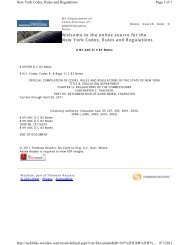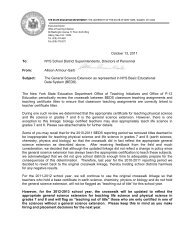ESL Learning Standards - Higher Ed - New York State Education ...
ESL Learning Standards - Higher Ed - New York State Education ...
ESL Learning Standards - Higher Ed - New York State Education ...
You also want an ePaper? Increase the reach of your titles
YUMPU automatically turns print PDFs into web optimized ePapers that Google loves.
Students learning English as a second language will use English to acquire, interpret, apply, and<br />
transmit information for content area learning and personal use. They will develop and use skills and<br />
strategies appropriate to their level of English proficiency to collect data, facts, and ideas; discover<br />
relationships, concepts, and generalizations; and use knowledge generated from oral, written, and<br />
electronically produced texts.<br />
Performance Indicators: See page 12<br />
Advanced<br />
Students complete Intermediate task. Students choose<br />
additional information about the selected occupation from<br />
texts in library or Internet to find varieties of this job (e.g.,<br />
volunteer vs. salaried firefighter, state police vs. local<br />
police, dentist vs. dental hygienist, small shop owner vs.<br />
supermarket employee). Students summarize information<br />
in a compare/contrast poster for display in classroom or<br />
school corridor.<br />
Performance indicators: 1, 2, 3, 4, 5, 7, 8, 9, 10, 12, 13, 16<br />
English Proficiency Level<br />
Transitional<br />
Students complete Advanced task. In small groups,<br />
students engage in a simulation activity. Teacher tells students,<br />
for example, that the mayor has only enough money<br />
to pay for 10 of the 12 occupations researched. Students<br />
decide which occupations should be eliminated and why.<br />
Each group presents conclusions to class.<br />
Performance indicators: 1, 2, 3, 4, 5, 6, 7, 8, 9, 10, 12, 13,<br />
16<br />
Students complete Intermediate task. Students read or listen<br />
to a fiction book on this topic (e.g., Just a Dream by Chris<br />
Van Allsburg). After discussion of the different environmental<br />
issues and the book’s message, class collaborates on<br />
creating an environmental board game to get this message<br />
across to others. (Small groups work on separate tasks,<br />
developing forward and backward moves based on environmental<br />
problems and solutions.)<br />
Performance indicators: 1, 3, 4, 6, 7, 13, 16<br />
Students listen to a variety of texts and take notes about<br />
the life cycle of frogs and salamanders. On the basis of<br />
their notes and readings, small groups create Venn diagrams<br />
showing differences and similarities. Groups research<br />
animals with similar characteristics (electronically or in<br />
print) and share information with class.<br />
Performance indicators: 1, 2, 3, 4, 7, 9, 10, 13, 16<br />
Students listen to and read information about the environment,<br />
using multiple sources (e.g., speakers, websites, nonfiction<br />
and fiction books including Just a Dream by Chris<br />
Van Allsburg and The Great Kapok Tree by Lynne Cherry).<br />
Students keep notes and use graphic organizers to organize<br />
information. Students reflect in dialogue journals on what<br />
they have learned, distinguishing between the various<br />
sources (e.g., fictional vs. nonfictional), and telling which<br />
they preferred and why. Students then draw their vision of<br />
the planet’s future and describe it, using the writing process.<br />
Students’ work is shared with the class and displayed<br />
on a hallway bulletin board.<br />
Performance indicators: 1, 2, 3, 4, 6, 7, 8, 9, 11, 12, 13, 16<br />
Working in pairs, students choose two animals (with some<br />
similar characteristics) to read about. Students take notes<br />
and collaborate to create Venn diagrams showing differences<br />
and similarities. Each pair of students prepares an<br />
oral and visual class presentation, including key concepts<br />
and supporting details from the texts. They design a quiz to<br />
check on classmates’ understanding.<br />
Performance indicators: 1, 2, 3, 4, 5, 7, 8, 9, 10, 12, 13, 16<br />
<strong>ESL</strong><br />
1<br />
Elem<br />
Continued on next page<br />
CLASSROOM<br />
TASKS<br />
Sample Classroom Tasks 43
















